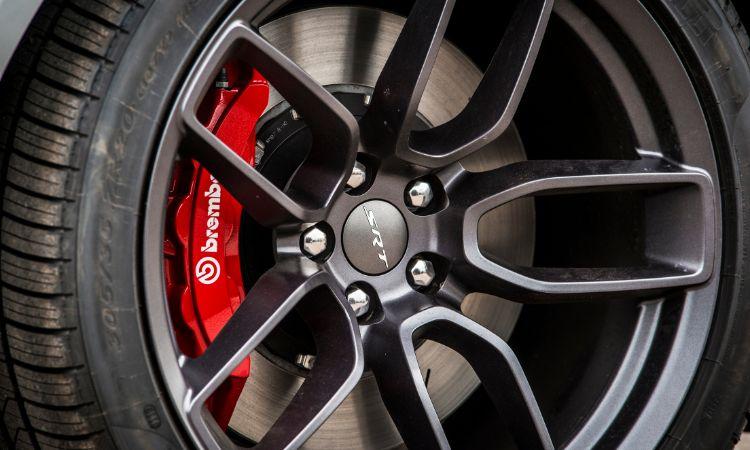The global automotive wheel rims market size stood at a value of around USD 20.8 billion in 2021. The market is further expected to grow in the forecast period of 2024-2032 at a CAGR of 8.21% to reach USD 33.4 billion by 2027. With these staggering numbers in mind, it’s clear that the automotive wheel rims industry is thriving. Wheel rims aren’t just functional components; they’re style statements and performance enhancers. Selecting the right wheel rims for your vehicle is a crucial decision that can impact not only the aesthetics but also the handling, safety, and efficiency of your ride.
In this comprehensive guide, we’ll take you through the process of choosing the right wheel rims for your vehicle. We’ll delve into the basics, explore the factors to consider, discuss various materials, talk about maintenance, budget considerations, safety, and even touch upon sustainability. So, let’s dive in and ensure that you make an informed decision when it comes to your vehicle’s wheel rims.
Understanding Wheel Rim Basics
Before we explore the factors to consider when choosing wheel rims, it’s essential to understand the basics. Wheel rims are the structural part of the wheel that holds the tire in place. They play a crucial role in ensuring the tire’s integrity, and they also contribute to the overall performance and aesthetics of the vehicle.
Different Types of Wheel Rims
Wheel rims come in various types, with the most common ones being:
1. Steel Wheel Rims
Steel wheel rims are the traditional choice and are known for their durability and strength. They are often found on budget-friendly vehicles and commercial trucks. While they may not be as flashy as alloy rims, they get the job done.
2. Alloy Wheel Rims
Alloy wheel rims are a popular choice among car enthusiasts. They are made from a blend of aluminum and other metals, making them lighter and more stylish than steel rims. Alloy rims come in a wide range of designs and finishes, allowing for greater personalization.
3. Forged Wheel Rims
Forged wheel rims are at the top of the wheel rim hierarchy. They are crafted from a solid piece of metal, making them incredibly strong and lightweight. These rims are often used in high-performance and luxury vehicles due to their exceptional quality.
Importance of Wheel Rim Size and Fitment
The size and fitment of your wheel rims are critical considerations. Using the wrong size or fitment can lead to performance issues, safety hazards, and a less-than-optimal driving experience. Here’s what you need to know:
Matching the Rim Size with the Vehicle’s Specifications
Your vehicle’s manufacturer provides specific recommendations for rim size and tire size. It’s essential to adhere to these recommendations to ensure proper clearance, handling, and safety. Installing rims that are too large or too small can lead to problems with alignment and suspension.
Load Rating and Weight Capacity
Each set of wheel rims has a load rating, indicating the maximum weight it can support. It’s crucial to choose rims that can handle the weight of your vehicle, passengers, and cargo. Neglecting this can result in premature rim failure and safety concerns.
Factors to Consider When Choosing Wheel Rims
Now that we’ve covered the basics, let’s explore the factors you should consider when selecting wheel rims for your vehicle.
Vehicle Compatibility
Matching the Rim Size with the Vehicle’s Specifications
As mentioned earlier, matching the rim size with your vehicle’s specifications is paramount. It ensures proper fitment and alignment. To find the recommended rim size for your vehicle, consult the owner’s manual or check the information placard located inside the driver’s door frame.
Load Rating and Weight Capacity
Consider the weight your vehicle will carry regularly. If you have a larger SUV or plan to use your vehicle for towing, you’ll need rims with a higher load rating. Conversely, smaller cars may require rims with lower load ratings.
Performance Considerations
Impact of Wheel Rim Weight on Handling and Fuel Efficiency
The weight of your wheel rims can affect your vehicle’s handling and fuel efficiency. Heavier rims can reduce your car’s agility, while lighter rims can enhance it. Additionally, lighter rims contribute to better fuel efficiency because there’s less rotational mass to overcome.
Aerodynamics and Its Role in Rim Design
Believe it or not, the design of your wheel rims can impact your vehicle’s aerodynamics. Streamlined rim designs can reduce wind resistance, potentially improving fuel efficiency. However, this effect is relatively subtle for most daily drivers.
Aesthetics and Customization Options
Choosing a Rim Design That Suits Your Vehicle’s Style
Wheel rims are an excellent way to personalize your vehicle’s appearance. There’s a vast array of designs, from classic to modern, and even avant-garde styles. Consider what suits your vehicle’s overall style and your personal preferences.
Finishes and Colors for Personalization
In addition to the design, you can also choose from various finishes and colors for your wheel rims. Common finishes include chrome, black, polished, and matte. Keep in mind that certain finishes may require more maintenance to keep them looking their best.
Material Selection: Alloy vs. Steel vs. Forged
The material of your wheel rims can significantly impact their performance and aesthetics. Let’s explore the pros and cons of the most common materials: alloy, steel, and forged.
Advantages and Disadvantages of Alloy Wheel Rims
Alloy wheel rims are a favorite among car enthusiasts for several reasons:
Pros:
- Lightweight, which improves handling and fuel efficiency.
- Stylish and available in a wide range of designs.
- Better heat dissipation, which can extend the life of your brakes.
Cons:
- More expensive than steel rims.
- Prone to bending or cracking if subjected to significant impacts.
- Susceptible to corrosion if not properly cared for.
Pros and Cons of Steel Wheel Rims
Steel wheel rims have been the go-to choice for many vehicles for decades:
Pros:
- Durable and can withstand harsh conditions.
- Budget-friendly option.
- Less susceptible to bending or cracking from impacts.
Cons:
- Heavier than alloy rims, affecting handling and fuel efficiency.
- Limited in terms of design options.
- Prone to rust and corrosion if the finish is damaged.
Benefits of Forged Wheel Rims
Forged wheel rims represent the pinnacle of wheel rim technology:
Pros:
- Exceptionally strong and lightweight, offering optimal performance.
- Highly resistant to bending or cracking.
- Ideal for high-performance and luxury vehicles.
Cons:
- The most expensive option on the market.
- Limited availability in terms of design and finish options.
- May require a larger initial investment.
Choosing the right material for your wheel rims depends on your budget, driving habits, and aesthetic preferences. If you’re looking for the best performance and are willing to invest, forged rims are the way to go. However, alloy rims strike a good balance between performance and cost, making them a popular choice for many drivers.
Maintenance and Care
Once you’ve selected the perfect wheel rims for your vehicle, it’s essential to maintain and care for them properly. Neglecting maintenance can lead to premature wear and deterioration. Here are some tips:
Tips for Cleaning and Maintaining Wheel Rims
-
Regular Cleaning: Wash your wheel rims regularly to remove brake dust, road grime, and other contaminants that can accumulate. Use a mild detergent and a soft brush or sponge to avoid scratching the finish.
-
Avoid Harsh Chemicals: Avoid using harsh chemicals or abrasive cleaners, as they can damage the finish of your rims. Stick to products specifically designed for cleaning rims.
-
Inspect for Damage: Periodically inspect your rims for any signs of damage, such as cracks or bends. If you notice any issues, have them repaired or replaced promptly.
-
Protect Against Corrosion: Apply a layer of wax or sealant to your rims to protect against corrosion and make them easier to clean in the future.
-
Proper Tools: Invest in wheel brushes and cleaning tools designed for rims. They can make the cleaning process more efficient and less likely to cause damage.
By following these maintenance tips, you can keep your wheel rims looking great and functioning optimally for years to come.
Budget Considerations
Budget is a crucial factor when choosing wheel rims for your vehicle. Wheel rims come in a wide range of price points, so it’s essential to find a balance between quality and cost-effectiveness.
Price Range for Different Types of Wheel Rims
The price of wheel rims can vary significantly based on several factors, including the material, brand, design, and size. Here’s a general price range for each type of wheel rim:
-
Steel Wheel Rims: These are typically the most budget-friendly option, with prices ranging from $50 to $200 per rim, depending on the size and brand.
-
Alloy Wheel Rims: Alloy rims are more expensive than steel, with prices ranging from $150 to $500 per rim. High-end alloy rims can cost even more.
-
Forged Wheel Rims: Forged rims are the most expensive option, with prices starting at $500 per rim and easily reaching $1,000 or more per rim for high-end models.
When setting your budget, consider the number of rims you need to purchase (typically four), as well as any additional costs for installation, tires, and maintenance.
Safety Considerations
Safety should always be a top priority when selecting wheel rims for your vehicle. Properly chosen and maintained wheel rims can enhance your vehicle’s safety, while the wrong choice can lead to dangerous situations.
The Role of Wheel Rims in Vehicle Safety
Wheel rims play a significant role in the overall safety of your vehicle in the following ways:
-
Wheel Integrity: Wheel rims are responsible for holding the tire securely in place. If a rim is damaged or compromised, it can result in a sudden tire blowout, leading to a loss of control and a potentially catastrophic accident.
-
Weight Distribution: The weight of your vehicle is distributed across all four wheel rims. If one rim fails or is damaged, it can disrupt the balance and stability of your vehicle.
-
Braking Performance: Properly designed and maintained wheel rims contribute to effective braking performance. Damaged or poorly chosen rims can hinder braking and increase stopping distances.
To ensure safety, always choose wheel rims that meet or exceed your vehicle manufacturer’s specifications and have them installed by a qualified professional. Regular maintenance and inspections are also essential to catch any issues before they become safety hazards.
Sustainability and Environmental Impact
In today’s world, sustainability is an important consideration for many consumers. Fortunately, there are eco-friendly options available in the world of wheel rims.
Eco-Friendly Options in Wheel Rim Materials
If you’re concerned about the environmental impact of your vehicle’s components, consider the following options:
-
Recycled Materials: Some wheel rim manufacturers use recycled materials in their production processes, reducing the demand for new raw materials and minimizing environmental impact.
-
Lightweight Materials: Lighter wheel rims, such as alloy or forged rims, can improve fuel efficiency by reducing the vehicle’s overall weight.
-
Low-Emission Manufacturing: Some companies prioritize low-emission manufacturing processes, reducing their carbon footprint.
-
Sustainable Finishes: Look for rims with eco-friendly finishes that don’t release harmful chemicals into the environment during their lifecycle.
By choosing eco-friendly wheel rim options, you can reduce your vehicle’s impact on the environment and contribute to a more sustainable automotive industry.
Case Studies
To provide a real-world perspective on the importance of choosing the right wheel rims, let’s explore a couple of case studies:
Case Study 1: Performance Enhancement
John, an automotive enthusiast, decided to upgrade his sports car with a set of lightweight alloy wheel rims. The new rims reduced the car’s unsprung weight, improving its handling and cornering capabilities. John also noticed a slight increase in fuel efficiency, thanks to the reduced rotational mass. This case study highlights how the right choice of wheel rims can enhance a vehicle’s performance.
Case Study 2: Safety and Durability
Sarah purchased a set of budget steel wheel rims for her SUV without considering the load rating. Over time, the rims began to show signs of stress and deformation due to the vehicle’s weight. One day, while on a road trip with her family, one of the rims failed, causing a dangerous situation on the highway. This case study underscores the importance of selecting wheel rims that can handle the demands of your vehicle.



